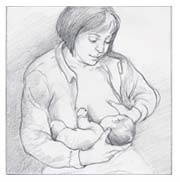Breastfeeding Position: Cross- Cradle
The most common breastfeeding position is the cross-cradle. This position gives the most support to the baby and the mother has complete control over her infant with just one arm.
The most common breastfeeding position is the cross-cradle. This position gives the most support to the baby and the mother has complete control over her infant with just one arm.
Here's How:
- Sitting comfortably with the baby at breast height using a pillow for support, tuck the baby's tush in the crook of the opposite arm of the breast being fed. The mother's forearm should be positioned up the length of the baby's back. The baby's head is supported by her thumb and forefinger, right behind the ears. The baby is held tummy-to-tummy with the mother
- Hold the breast that is being fed in a "U" shape. Hold the breast with the thumb on the outer part of the breast and the remaining fingers on the inner side. (Make sure the fingers are back against the chest wall and not too close to the nipple.) The best analogy to make is that of a sandwich. By squeezing the "U", we make a sandwich for the baby: This makes the breast more compact and easily graspable. When adults eat sandwiches they don't stick their whole head into it...they press it together to "latch" onto it as easily as possible. This is the same concept.
- Line up the baby so that the nipple is opposite the baby's nose.
- Tickle the baby's lips with the nipple and pull back slightly until the baby has a wide open mouth. (Do not allow the baby to glide onto the nipple. This will cause sore, painful nipples and at the same time, the baby will not be able to remove an adequate amount of milk from the breast.)
- When the baby opens wide, quickly push his whole body in toward you and make sure that the latch feels comfortable. The baby's upper lip may just hit above the top of the nipple. Most often, mothers will see more of the areola above the upper lip than below it. If there is a pinching feeling, the mother can pull down on the baby's chin, while still latched on, and attempt to "flip" the baby's bottom lip out. If not, she needs to take the baby off the breast and relatch. Remember that babies do not nipple feed, they breastfeed, and they really need to latch on to the underside of the breast.
- The baby's nose to chin should be touching the breast. Try not to press the thumb into the breast to make an "airway" for the baby. This can force the nipple upward and rub against the roof of the baby's mouth, causing nipple abrasion. Babies can breathe absolutely fine while nursing and if they are stuffy, mucousy, or otherwise having breathing trouble, they will pull off the breast themselves.
- If the latch was perfect, the nipple will come out round and the mother will be comfortable. If the nipple comes out angular or looking like the tip of a new tube of lipstick, and the mother has pain, the latch was incorrect. If she doesn't know what she's doing wrong, a lactation consultant can help to fix the problem.
The cross-cradle position allows you to have more control over how your baby latches on. Many moms find they are able to get their babies latched on more deeply with this hold.


No comments:
Post a Comment